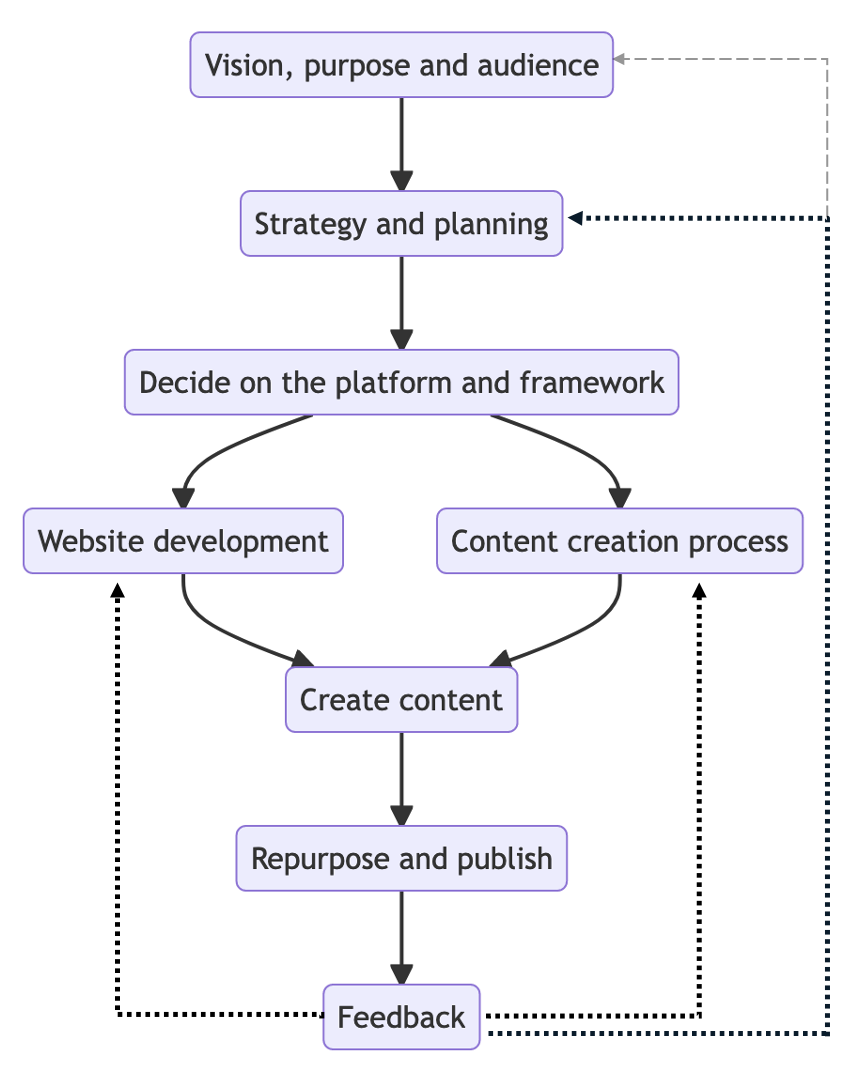Last year, I decided that I wanted to share my knowledge on how to practically implement effective AI systems and my personal thoughts about AI with a wider audience. I realized that creating a personal website would be the perfect way to structure this knowledge for myself and, hopefully, connect with like-minded professionals. Along the way, I developed a clear blueprint to make the website creation journey smooth and effective.
After reflecting back on the steps that I took to develop this website and start publishing content, I came up with the following high level process (see exhibit below). I hope will help those just starting on this path. In upcoming articles, if there is enough interest, I plan to delve deeper into each step.

This process is probably not perfect but it what worked for me. Note, that some of the steps were quite new to me, so I had to discover (and I am probably still discovering it) while working on it.
Here’s the high level description of the steps:
-
Vision, purpose and audience. Before diving into website creation, it’s crucial to establish a clear vision and purpose—the WHY. It is also important to think through who your audience will be. This will serve as a north star as you move through the other stages. I spent a few weeks, on and off, just thinking and drafting this.
-
Strategy and planning. Once you know your WHY and the audience, it is time to put together a plan on how to execute it over the next 1-2 years, including components you want, what you need to learn, and a rough vision for growth. At this stage, I also outlined my functional requirements for the project, such as what I want from the website, functionality of my newsletter, and video content sharing capability (coming soon!).
-
Decide on the platform and frameworks. After clarifying your functional requirements, start thinking about platforms and clouds to run the website, as well as frameworks that help you speed up creation. This stage involves quick experimentation and understanding the pros and cons of each platform and frameworks. Without going into too much detail, I ended up choosing AWS Cloud for content hosting, Jekyll static website generator, and Git to store content.
- Website development. The actual process of setting up:
- AWS cloud services: Route 53 DNS, S3 buckets, Cloudfront, IAM
- Other services: Github, Substack, Google forms, social media
- Developing and configuring the Jekyll code, the templates, configuring colours, custom functinality
-
Content creation process. This involves setting up a personal process for idea generation, prioritisation, research, and drafting outlines. I used Notion to capture my ideas and generate drafts.
-
Create content. This step actually creates content based on the ideas and drafts from the content creation process. I heavily use ChatGPT to help with writing articles once I have the outline created.
-
Repurpose and publish. Each piece of content can ideally be reused across multiple platforms. In my case, it is my newsletter, website blog, and LinkedIn posts. In the future, it can hopefully feed my videos and other content platforms as well.
- Feedback. The magic of this whole process is to iterate on each of the previous steps and improve as quickly as possible. To do this, I constantly ask for feedback at all stages. For example, during the vision and strategy steps, I reached out to some of my friends and mentors to seek their feedback. After the first few articles, I had a semi-silent launch for a small group of people who provided me with their feedback. Now I try to seek feedback from polls and comments.
Creating a personal website is a rewarding learning journey that can help you share your knowledge and connect with like-minded individuals. By following a version of the steps I outlined in this article, you’ll be well on your way to establishing a successful online presence. If there’s enough interest, I plan to expand on some of the most interesting steps of this process.
This article reflects my personal views and opinions only, which may be different from the companies and employers that I am associated with.
